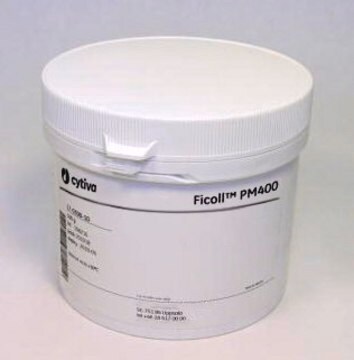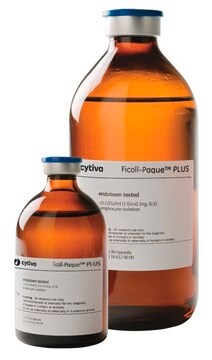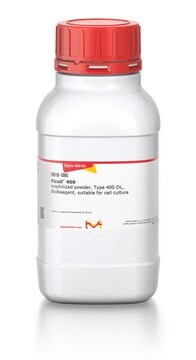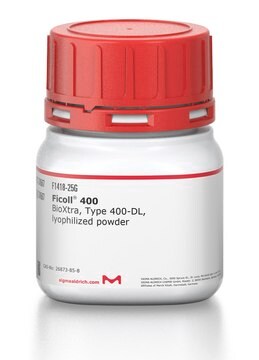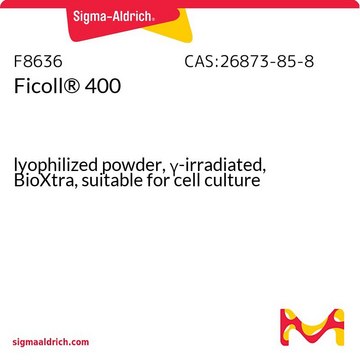GE17-0300-50
Ficoll® PM 400
Cytiva 17-0300-50, pack of 500 g
Sinónimos:
Ficoll Density Gradient
About This Item
Productos recomendados
form
solid
spray-dried
packaging
pack of 500 g
manufacturer/tradename
Cytiva 17-0300-50
color
White
solubility
soluble
General description
Ficoll® PM400 is a synthetic neutral, highly-branched hydrophilic polymer of sucrose with an average molecular weight of 400 000. It has long been used to form density gradients for separating and isolating eukaryotic cells, organelles and bacterial cells, as a stabilizing agent, and as a preparation medium for isolating mononuclear cells. Applications can also be found in defined culture media, nucleic acid hybridization, electrophoresis, and immunological studies.
Application
It also has applications in defined culture media, nucleic acid hybridization, electrophoresis, and immunological studies.
Used for gradient centrifugation in all types of centrifuge rotors and for separation at unit gravity.
Features and Benefits
- For producing density gradients for separation of cells and subcellular components by centrifugation or by sedimentation at unit gravity.
- Neutral, highly branched, hydrophilic polymer of sucrose which dissolves readily in aqueous solution.
- Concentrations of up to 50% (w/v) covering densities of up to 1.2 g/mL can be achieved.
- Better osmotic properties than sucrose.
- Preserves functional and morphological integrity.
- Useful for separating cells that are sensitive to centrifugation and for separating cells of similar density but different size (under conditions of sedimentation at unit gravity).
- Does not penetrate biological membranes.
- Serves as the raw material for preparation of Ficoll-Paque gradients.
- Used in other applications such as electrophoresis, hybridization, cryopreservation, and as a hapten carrier.
Storage and Stability
Analysis Note
Legal Information
Storage Class
13 - Non Combustible Solids
Certificados de análisis (COA)
Busque Certificados de análisis (COA) introduciendo el número de lote del producto. Los números de lote se encuentran en la etiqueta del producto después de las palabras «Lot» o «Batch»
¿Ya tiene este producto?
Encuentre la documentación para los productos que ha comprado recientemente en la Biblioteca de documentos.
Los clientes también vieron
Artículos
This page shows methods to remove Percoll from a sample after centrifugation.
The effects of the mononuclear cell separation method described by Bøyum procedure are noted below, since research situations may arise in which they are significant.
Density Marker Beads are dyed derivatives of Sephadex™. There are ten color-coded bead types, each with a specific density. They have been specifically formulated for use in Percoll gradients and will not work with other media. Using Density Marker Beads as an external marker facilitates monitoring of the gradient shape and range.
The table was compiled to assist the researcher in selecting references most likely to contain relevant information regarding use of Percoll in various cell types.
Protocolos
How to use percoll to prepare a gradient
Contenido relacionado
Data was compiled to assist the researcher in selecting references most likely to contain relevant information regarding use of Percoll for a particular cell or tissue type.
Nuestro equipo de científicos tiene experiencia en todas las áreas de investigación: Ciencias de la vida, Ciencia de los materiales, Síntesis química, Cromatografía, Analítica y muchas otras.
Póngase en contacto con el Servicio técnico